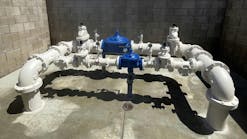Photos courtesy Idrica.
The search for water efficiency, both in water utilities and among citizens, will drive investment in AMI in the coming years, according to a new release from smart water company Idrica:
From Meters to Intelligence
For some years now, water utilities have been investing in the digital transformation of micro-metering as a way to extract value from data and turn information into business intelligence.
Growing investment in advanced metering infrastructure (AMI) systems globally is intended to help businesses and consumers make better decisions — not just reactive or corrective ones. AMI helps users to predict. It is a groundbreaking tool thanks to the amount of information it can generate.
The Road to Big Data
According to Carlos Tejedor, smart metering and instrumentation specialist at Idrica, developments in meters are one of the most important advances of the last 50 years in the water industry. From the first innovations, centering on faster, remote reading (walk-by and drive-by), which was mainly geared towards billing, the meter becomes an IoT sensor that transmits useful information to digitally transform all processes in AMI systems.
If the term automatic meter reading (AMR) refers to remote reading using smart meters connected to communication devices, AMI goes one step further.
“It focuses not only on data collection, but also on its integration and processing using Big Data technologies,” said Tejedor. “Platforms are a key element of these infrastructures, which are the most mature in the micro-metering field. Their aim is to offer value-added services and to manage water resources more efficiently. For example, developing algorithms to detect leaks and predict demand.”
To achieve this, Tejedor points out that “AMI must ideally process consumption data on an hourly basis with optimum quality. Compared to proprietary protocols and LPWAN technologies, such as SigFox and Lora, new communication protocols (NB-IoT, 5G) are helping to make this a reality due to their greater scope, penetration and coverage. In addition, they enable more efficient battery management, which is essential if we take into account smart metering’s need to frequently send data.”
AMI benefits:
- Increased operational efficiency
Operators can associate consumption data with other data sources— such as SCADA — to optimize processes. It can reduce OPEX and help predict water demands in advance, according to Idrica. - More sustainable use of resources
AMI reduces the volume of non-revenue water by conducting hourly water balances. It also reduces consumption of fuel that would otherwise be spent on manual meter readings. - Value-added services for citizens
Data analysis opens the door to useful services: such as alerts for domestic leaks, curated water use data, and billing based on actual readings.
2022: more metering for better management
Today, society demands a commitment from companies and utilities to ensure responsible water consumption, in line with the Sustainable Development Goals.
According to the World Bank, by 2030, there will be a 40 percent world shortfall between the forecast demand for water and the amount available. In the light of this situation, governments and social partners are highly likely to support technologies that represent a step forward in terms of sustainability.
“AMI is one of these technologies, as it helps us to take the first step towards process improvement through metering,” said Tejedor. “More and more utilities understand that these infrastructures not only facilitate billing, but also serve to improve leak detection, forecast demand through algorithms, increase customer satisfaction, fine tune digital twin simulations, and reduce CO2 emissions.”
Digital transformation in the water industry will gather speed in the coming years.
Right now, many water utilities use different communication technologies (NB-IoT, LoRa, Sigfox, etc.) and meters manufactured by different vendors. However, accelerating digital transformations will change this.
“Big Data platforms that standardize information and help us to convert it into business intelligence will be one of the main trends for 2022," said Tejedor. “The increased use of sensors we expect to see poses one of the main challenges for AMI: the coexistence of smart metering with other smart devices."
Utilities’ commitment to AMI deployment is one of the trends for 2022, which are listed in Idrica’s Water Technology Trends 2022 report.



